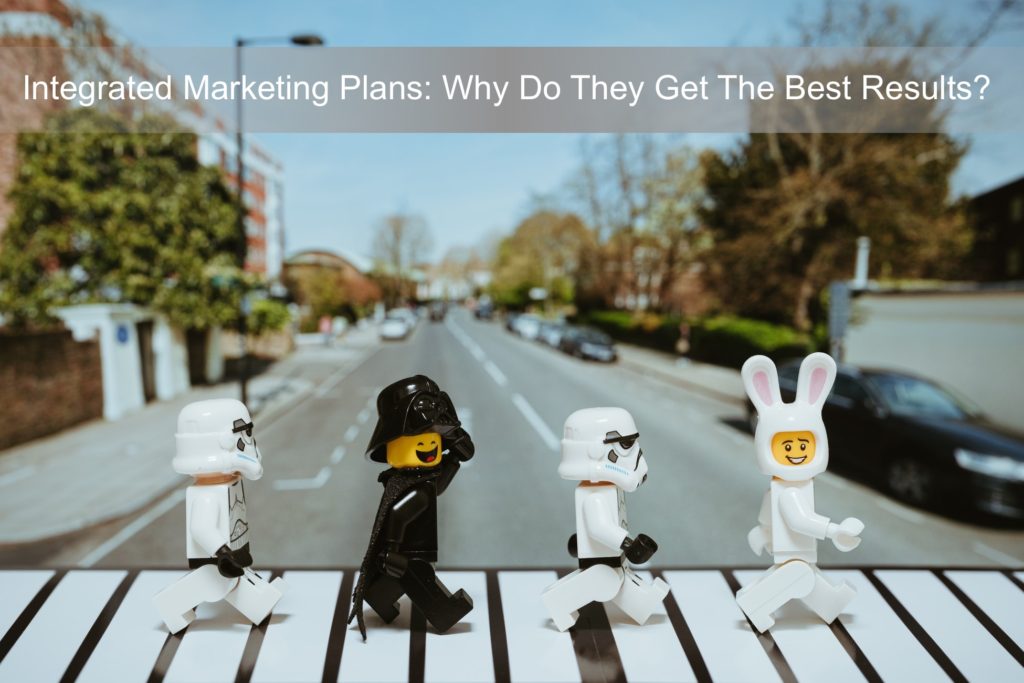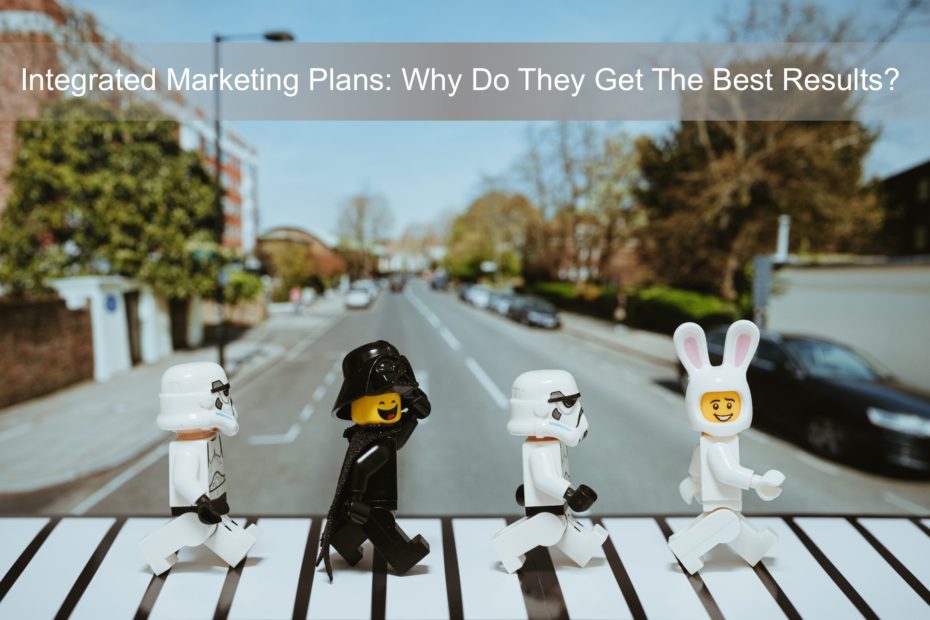
I really like integrated marketing plans and for good reason. They perform better.
But why?
That’s a good question but we are jumping ahead. Let’s take a step back first and get on the same page.
First I’m going to talk about what integrated marketing is and then we will get into planning. I’m also show you some examples of how integrated marketing plans work.
Once you start thinking about planning from a perspective of integration, it’s hard to go back to a model where social media, your website, advertising, and media relations all reside in their own silos.
What’s Integrated Marketing?
When I graduated from college I applied for public relations (PR) position with an agency and as part of the process, I was asked to create an IMC plan for a business example I was given. I had never heard of IMC before.
It’s not something we ever talked about in school so I had to google it to figure out what it was. The acronym stood for Integrated Marketing Plan. Helpful but not enlightening.
I kept searching and found this definition by the American Marketing Association, “a planning process designed to assure that all brand contacts received by a customer or prospect for a product, service, or organization are relevant to that person and consistent over time.”
Clear as mud? That’s what I thought too.
I kept searching and found something along the lines of this definition: Integrated marketing communications can be defined as the process used to unify marketing communication elements, such as public relations, social media, and advertising, into a brand message that remains consistent across distinct media channels.
This was more helpful so I ran with it and created a plan. As you might imagine, I didn’t get the job. It wasn’t surprising because I didn’t particularly know what I was doing. A definition isn’t a substitute for the actual knowledge that I needed to create an IMC plan.
I went to Amazon and ordered a textbook titled, Integrated Marketing Communications: Creative Strategy From Idea To Implementation. 300 pages later I finally knew what IMC was, or, I should say I understood it enough to be dangerous.
As PR person I was still wasn’t 100% sure why I should be using IMC as part of my job but eventually, I would run across a model that would make integrated marketing more clear to me.
While the definition I used for my employment test is helpful I think I can give you a more simple definition. Integrated marketing combines elements of marketing and communication that work together to help your business reach a common goal.
The key here is that marketing and communication efforts work together. In many organizations, the social media manager only focuses on social, the marketing people only focus on marketing, the PR people only focus on media relations.
While they may all be good at their jobs, they aren’t working together. Yes, they will get results but because they are all of doing their own thing, synergy is missing.
If your teams are in their silos, they will all still meet your customers at some point but the messaging will be inconsistent which will confuse your customers. This doesn’t breed trust or action.
The world we live in has changed. Marketers are no longer in control. If there is only one idea you take away from this article is should be this: Customers are in control. Your job is to have the right piece of content for them at the right time.
What is an Integrated Marketing Plan?
When I worked at Intel, we never did anything without having a plan first. It left a strong impression and when I left the company after nearly seven years later, I was a strong advocate for planning.
For those of you playing devil’s advocate thinking that plans won’t hold up over the course of the year and pointing at 2020 as the example, I can’t argue with you. Sometimes things come up that weren’t foreseen and adjustments have to be made.
Plans aren’t set in stone. They should be adjusted as necessary during the course of the year. There is rarely a good good excuse not to plan. This is true whether there is a year like 2020 or a year like 2019.
I’ll step off the pulpit now.
An integrated marketing plan lays out how your are going to achieve your goals using elements of marketing and communication.
The PESO model, developed by Gini Dietrich at Spin Sucks, not only lays out the foundation of the tactics that can be used for your plan but it also helps you devise your strategy.
What I really like about PESO is it breaks everything down into elements that anybody can understand.
Paid media is digital advertising. It creates awareness.
Earned media is better known to most people as media relations. This is the placement of articles within the media. Earned media creates awareness, helps build thought leadership, and helps your searching engine optimization (SEO) by getting you backlinks and creating authority.
Shared media is social media. It creates awareness, promotes your organization, and helps you make connections with people.
Owned media is where you own the channel and the message. There are only two things you own, your website and your email list. Owned media is is your digital storefront. It’s where you do business online. It contains information on your organizations and your product/services and helps move people down the funnel so they purchase.
Think of the PESO model like a football team. Would you show up to the football game with just the offense? No. You would get some results but the overall game wouldn’t go well. To have a football team and a chance to win, you need offense, defense, and special teams. They all need to do their jobs to reach the goal which is winning the game.
PESO contains all the elements you need to get to your goals.
Developing an Integrated Marketing Plan
I’m not going into great detail on developing a plan because its in depth process. We spend two days working with our clients to develop a plan (If you want to get an idea of our planning process after you’ve finished reading, check out our strategic planning page under the “Services” tab above).
Every plan should start out with defining your business goals. Integrated marketing is a business process and you don’t know where you’re going, all the planning and marketing in the world won’t be much help.
At its most basic, once you have business goals defined, you can begin developing your marketing plan.
Not every business goal will be supported by a marketing or public relations action. If a business goals is to develop a new product, integrated marketing can’t help but if the business goal is to sell x amount of a product, it can come into play.
Once you have identified which business goals can be tied to integrated marketing you need to determine your marketing goals. Think of goals as your destination. It’s where you want to go.
Next, you want to define your strategy. If goals are your destination, strategy is how you get there.
Don’t overcomplicate it. It can be as simple as, “Use advertising to drive people to our landing page.”
Many people think of PESO only in tactical terms but I find it also lends itself to defining strategy. When I’m creating a strategy I always ask myself on how PESO can help me reach my goals.
Objectives are the markers on the way to your goals. Think of the this way, if you broke down your goal into pieces, those pieces would be the objectives. They are the measurable steps that you use to see how your progressing towards your goals.
Finally we have the tactics. This is the action you take to achieve your objectives.
Everything you do should be measurable. If it’s not, you won’t be able to prove the value of your efforts.
If you walk through these steps, you will have a simple but actionable plan that will help you get real business results.
Integrated Plan Examples
I’ve been telling but now it’s time to show. Let’s look at two examples that show integrated marketing plans and its power to get results. Because I use the PESO model I’m going to show the integrated examples inside this framework. For the sake of time, I’m also going to keep these simple. The goal is to show you what integrated plan could look like.
B2C Integrated Marketing Example
Our example is business-to-consumer (B2C) technology company named Ovenco who sells smart ovens. The ovens sell for $1500 each and the primary goal is to make $10 million in revenue for the year. This equates to 6,667 sales. The product is only sold over the phone. The target audience is people who like to cook.
The sales team has a 20% close rate. The marketing team’s goal is to get the sales team leads. More specifically marketing needs to send sales 33,335 leads. This is the marketing goal.
The following marketing strategy has been laid out:
- (Paid media) Use digital ads to drive consumers to the website
- (Earned media) Place articles on technology sites, consumer sites, blogs, and newspapers that drive consumers to the website and increase the site’s SEO
- (Shared media) Share content (product information, testimonials, pictures, video) on Facebook, Instagram, and Twitter that create awareness and interest to drive consumers to the website.
- (Owned media) Create content (product information, testimonials, pictures, video) that pull people through the funnel to make a purchase.
This strategy could more complex but it’s only intended to give you an idea of a strategy. Notice how it ties to the business and marketing goals. The business goal is to sell 6,667 smart ovens. Marketing’s goal is to create 33,335 leads. Paid media, earned media, and shared media are all focusing on driving people to the website which is owned media. The website is working to turn those people into qualified leads for the sales team.
The marketing objective is to create 2,778 leads a month.
Now we get into the tactics which will get more specific. Before I list the tactics, the marketing team has decided to focus on the following message with all of the tactics: There has never been an oven that is easier to use or has produced better results. The Smart Oven from Ovenco.
Here are some tactics that are being used:
- Paid media
- Google ads showcasing the message.
- Facebook ads showcasing the message
- Instagram ads showcasing the message
- Native ads showcasing the message
- Shared media
- Facebook, Twitter, and Instagram and posts sharing content on the website
- Quick takes on the Smart Oven that include links to relevant content on the website
- 20 second videos on the smart oven shared on Facebook, Instagram, and Twitter
- Earned Media
- Articles pitched to technology sites about how the Smart Oven is the next step in technologically for ovens
- Article pitched to Good Housekeeping on how the Smart Oven is to use and how it produces perfect results every time.
- Pitch interview to CNBC for interview with CEO that talks about the company and the Smart Oven
- Pitch articles to cooking blogs on how the ease of use and superior results that Smart Oven will deliver.
- Owned Media
- Blog posts that talk about the advantages of the Smart Oven over regular ovens
- Blog posts that talk about cooking with the Smart Oven and how it is a superior to regular ovens
- Blog posts that talk about how much time people are going to save with the Smart Oven
- Videos that show the smart oven being used
- Videos that show testimonials of people who own the oven
- Chart comparing the Smart Oven to regular ovens
This is fictitious product but you get the idea. The messaging stays consistent. The oven is easy to use and provides better results. This pushes the subconscious message that this is a much better oven than regular oven.
The message is on shared media, it’s being promoted via paid media and earned media. The website contains that same messaging but it’s designed to pull the customer through a marketing funnel to make a purchase.
Everything is working together to reach a common goal.
B2B Integrated Marketing Example
Healthco is a company aims to have a nurse practitioner on site for companies. It’s a premium service that costs $1 million a year. This means that Healthco targets medium and large companies make a minimum of $100 million in revenue a year.
Healthco’s goal is to make $300 million in revenue. The sales team has a 30% conversion rate. The service is sold directly to businesses via a sales meeting.
Marketing’s goal is to produce 1,000 leads.
Here is the strategy:
- (Paid media) Use digital ads to send people to the website and sales
- (Shared media) Use shared media to send people to the website
- (Earned media) Use earned media to create awareness and interest that results in people visiting the website
- (Owned media) Create content that shows the advantages of having a medical professional onsite.
The objective is to drive 84 leads a month to sales.
The messaging focuses on how much time and money will be saved in the long term when employees can visit a nurse practitioner onsite vs. taking time off of work to see a doctor.
The tactics are:
- Paid Media
- LinkedIn ads that showcase the message
- Google ads that showcase the message
- Earned Media
- Business outlets and blogs (Inc, Forbes, Fortune, etc.)
- Shared Media
- Share information posted to the website on LinkedIn
- Owned Media
- Blog content focusing on medical information relating to businesses
- Videos of nurses stating what they do
- Video testimonials
I pared down the tactics in this example because they are similar to our BC2 example but you get the idea. The biggest change outside of the product is that your target. It’s a company instead of a single person and this influences the strategy and the tactics.
LinkedIn is going to take the lead with paid media instead of Google and Facebook because it’s a site that caters more to companies and professionals. However, if you know your audience is on Facebook, that would be the primary paid media channel.
In both these cases, marketing focused on creating leads. It could be to make sale or make donation. Most companies, at the end of the day want leads. Now, how they get turned into leads is another conversation because it is rare that somebody is going to make a jump from a lead to buying because they saw an ad or a blog post. There are sorts of steps in between and that would be called out in your goals and/or objectives.
I wanted you to see that even though the audience changes from B2C to B2B, the idea of an integrated marketing plan doesn’t. It’s still about using marketing and communication elements together to reach a common goal.
Integrated Marketing Is The Future
Integrated Marketing takes more work but make no mistake about it. It is both the present and future.
The digital future has accelerated with the pandemic. This means integrated marketing becomes even more important.
25 years ago channels were still mainly television, radio, and print.
With the rise of the internet and everything that has come with it has fragmented the audience for every company.
Integrated marketing meets people where they are at the right time with consistent messaging that will spur them to take the next step. This is why it performs better.
Your customers are now in charge and the best way to reach them by embracing integrated marketing. Your future depends on it.
*Photo by Daniel Cheung on Unsplash
- Is Your Marketing Connected? - March 6, 2025
- Stop Planning and Start Strategizing - October 24, 2024
- The Importance of Creating a Connection With Your Marketing - June 6, 2024

